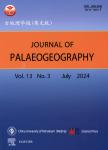Diversified calcimicrobes in dendrolites of the Zhangxia Formation, Miaolingian Series(Middle Cambrian) of the North China craton
Diversified calcimicrobes in dendrolites of the Zhangxia Formation, Miaolingian Series(Middle Cambrian) of the North China craton作者机构:School of Earth Sciences and ResourcesChina University of GeosciencesBeijing 100083China State Key Laboratory of Biogeology and Environmental GeologyChina University of GeosciencesBeijing 100083China State Key Laboratory of Oil and Gas Reservoir Geology and ExploitationChengdu University of TechnologyChengdu 610059China College of Energy ResourcesChengdu University of TechnologyChengdu 610059China Centre for Geographical Information SystemUniversity of the PunjabLahore 54590Pakistan.
出 版 物:《Journal of Palaeogeography》 (古地理学报(英文版))
年 卷 期:2021年第10卷第2期
页 面:157-181页
核心收录:
学科分类:0709[理学-地质学] 07[理学] 071005[理学-微生物学] 0303[法学-社会学] 0710[理学-生物学] 1007[医学-药学(可授医学、理学学位)] 100705[医学-微生物与生化药学] 0708[理学-地球物理学] 0705[理学-地理学] 0815[工学-水利工程] 0813[工学-建筑学] 0833[工学-城乡规划学] 10[医学]
基 金:funded by the National Natural Science Foundation of China(Grant No. 41472090)
主 题:Calcified microbe Dendrolite Leiolite Epiphyton Lithocodium–Bacinella Cambrian Miaolingian Zhangxia Formation
摘 要:As a type of non-laminated microbial carbonates, dendrolites are dominated by isolated dendritic clusters of calcimicrobes and are distinct from stromatolites and thrombolites. The dendrolites in the upper part of the Miaolingian Zhangxia Formation at Anjiazhuang section in Feicheng city of Shandong Province, China, provide an excellent example for further understanding of both growth pattern and forming mechanism of dendrolites. These dendrolites are featured by sedimentary fabrics and composition of calcified microbes as follows.(1) The strata of massive limestones, composed of dendrolites with thickness of more than one hundred meters, intergrade with thick-bedded to massive leiolites, formimg the upper part of a third-order depositional sequence that constitutes a forced regressive systems tract.(2) A centimeter-sized bush-like fabric(shrub) typically produced by calcified microbes is similar to the mesoclot in thrombolites but distinctive from clotted fabrics of thrombolites. This bushlike fabric is actually constituted by diversified calcified microbes like the modern shrub as a result of gliding mobility of filamentous cyanobacteria. Such forms traditionally include: the Epiphyton group(which actually has uncertain biological affinity), the Hedstroemia group which closely resembles modern rivulariacean cyanobacteria,and the possible calcified cyanobacteria of the Lithocodium–Bacinella group.(3) Significantly, dense micrite of leiolite is associated with sponge fossils and burrows, and is covered by microstromatolite. The Lithocodium–Bacinella group is a controversial group of interpreted calcified cyanobacteria in the Cambrian that has also been widely observed and described in the Mesozoic. Therefore, dendrolites with symbiosis of leiolites in the studied section provide an extraordinary example for further understanding of growing style of bush-like fabrics(shrubs) of the dendrolites dominated by cyanobacterial mats. Furthermore, the present research provid



